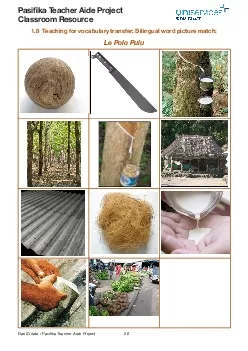

26Le Polo PuluPasix00660069ka Teacher Aide PronectClassroom ResourceRae Six0027ilata Pasix00660069ka Teacher Aide Pronect2718 Teaching for vocabulary transfer Samoan Bilingual Word Match Le Polo Pu ID: 870149
Download Pdf The PPT/PDF document "18 Teaching for vocabulary transfer Bil..." is the property of its rightful owner. Permission is granted to download and print the materials on this web site for personal, non-commercial use only, and to display it on your personal computer provided you do not modify the materials and that you retain all copyright notices contained in the materials. By downloading content from our website, you accept the terms of this agreement.
1 26 1.8 Teaching for vocabulary transfer
26 1.8 Teaching for vocabulary transfer: Bilingual word picture match: Le Polo Pulu Pasi�ka Teacher Aide Pronect Classroom Resource Rae Si'ilata / Pasi�ka Teacher Aide Pronect 27 1.8 Teaching for vocabulary transfer: Samoan Bilingual Word Match: Le Polo Pulu rubber cricket ball polo pulu rubber pulu / pa’u machete sapelu tree la’au ooze tafetafe lemu house fale corrugated iron apa coconut �bre pulu latex apulupulu peel fofo’e market maketi 28 1.8 Teaching for vocabulary transfer: Tonga
2 n Bilingual Word Match: Le Polo Pulu rub
n Bilingual Word Match: Le Polo Pulu rubber cricket ball fo’i pulu kilikiti ulapa rubber ulapa machete helepelu tree ‘akau ooze tafe house fale corrugated iron kapa coconut �bre kavele’i pulu latex to‘i akau peel fohi market m keti 29 1.8 Term & De�nition Match: Vocabulary: Le Polo Pulu rubber strong, sticky, elastic material (pulu) ball round object used in games (polo) tree trunk main stem of a tree (oga la’au) particles small speck or bit latex milky �uid from the rubber tree used f
3 or making rubber (pulu) machete heavy bu
or making rubber (pulu) machete heavy bush knife used for cutting (sapelu) corrugated iron metal sheets used for roo�ng (apa) �bres of the coconut husk stringy, thin threads from the coconut (pulu) Samoan cricket ball ball made from rubber (le polo pulu) 30 1.8 Using visual text : Making a Kilikiti Ball, source Joshua-Milo Si’ilata 31 1.8 Using visual text as a way of expanding language: Strip text: Le Polo Pulu
4 Scho
School Journal Part 2 Number 2 1999 Mikaele gets up early to collect latex from the pulu trees near his village. Mikaele cuts the pulu trees and the milky latex oozes out. He mixes the latex with water to stop it becoming too thick and sticky. He paints the latex on to the corrugated iron then peels the strips k� sdan pdau ana dnu. He stretches the latex strips around a ball of old rubber. He adds his new ball to the other balls he has already made, to sell at the market in Apia. 32 1.8 Using vi
5 sual text as a way of expanding language
sual text as a way of expanding language: Strip text: Le Polo Pulu School Journal Part 2 Number 2 1999 Mikaele makes rubber cricket balls to sell at the market in Apia. The rubber to make the cricket balls comes from the pulu tree. He needs to get up early before school to collect latex from the pulu trees near his village. Latex is a milky, white liquid found under the bark of the pulu tree. It contains tiny particles of rubber. By the time pulu trees are six years old, they have slash marks and blotchy, white stains from being tapped for
6 latex. Early in the morning is the best
latex. Early in the morning is the best time to collect latex. It is cooler and it �ows more freely. Mikaele makes a slanting cut with his machete, being careful not to damage the wood underneath. The milky latex oozes out, dripping slowly down the trunk. Mikaele scrapes the latex from the bark, onto a large taro leaf with his �nger. When he has collected enough latex for one cricket ball, he takes it back to his fale. He mixes it with water to stop it becoming too thick and sticky. Next he drags some sheets of corrugat
7 ed iron into the sun and cleans of
ed iron into the sun and cleans o� any dirt and dust. Then he uses coconut �bre to paint the latex onto the corrugated iron. He leaves the strips of latex to dry. He squeezes the pieces together in a small ball. When the strips of latex are dry, he peels them o� the corrugated iron and rolls them around the ball. He stretches the rubber carefully around the ball to make the surface of the ball He adds it to the other balls he has already made. Two dozen – enough to sell at the market in Apia on Saturday